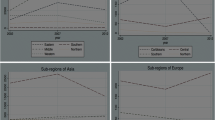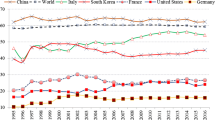Abstract
In this paper, we propose a conceptual framework for constructing a diffusion index of changes in overall perceptions with respect to corruption. The corruption diffusion index we construct lies between 0 (the greatest overall deterioration in corruption perceptions) and 100 (the greatest overall improvement in corruption perceptions) with 50 (no change in corruption perceptions) as the critical reference. The proposed methodology is applied to the 2010/2011 global corruption barometer survey data. Possible refinements of the proposed methodology to capture the potentially multi-dimensional nature of corruption and the practical challenges associated with the empirical implementation are discussed.
Similar content being viewed by others
Notes
One example is the surveys used in the construction of the Bribe Payers Index (BPI). For an overview of BPI, see http://www.transparency.org/research/bpi/overview.
For further details about the 2012 CPI and earlier CPIs see http://www.transparency.org/research/cpi/overview.
For further details in the nature of the GCB questions and the methodology see Transparency International’s website http://www.transparency.org/research/gcb/overview.
The reports are available at the ISM website http://www.ism.ws/ISMReport/?navItemNumber=22442. A similar methodology is also being used to construct PMIs for several other countries.
For example, the World Bank’s Country Policy and Institutional Analysis (CPIA) measure of corruption also considers these three dimensions. The corruption measure constructed by the World Bank ranges from 1 (low corruption) to 6 (high corruption). For further details, see the World Bank Group, CPIA database at http://data.worldbank.org/indicator/IQ.CPA.TRAN.XQ.
References
Aidt, T. S. (2003). Economic analysis of corruption: A survey. The Economic Journal, 113, F632–F652.
Akça, H., Ata, A. Y., & Karaca, C. (2012). Inflation and corruption relationship: Evidence from panel data in developed and developing countries. International Journal of Economics and Financial Issues, 2, 281–295.
Al-Marhubi, F. A. (2000). Corruption and inflation. Economics Letters, 66, 199–202.
Asiedu, E., & Freeman, J. (2009). The effect of corruption on investment growth: Evidence from firms in Latin America, sub-Saharan Africa, and transition countries. Review of Development Economics, 13, 200–214.
Bardhan, P. (1997). Corruption and development: A review of issues. Journal of Economic Literature, 35, 1320–1346.
Beck, P. J., Maher, M. W., & Tschoegl, A. E. (1991). The impact of the foreign corrupt practices act on US exports. Managerial and Decision Economics, 12, 295–303.
Bentzen, J. S. (2012). How bad is corruption? Cross-country evidence of the impact of corruption on economic prosperity. Review of Development Economics, 16, 167–184.
Campos, J. E., Lien, D., & Pradhan, S. (1999). The impact of corruption on investment: Predictability matters. World Development, 27, 1059–1067.
Cho, D. I., & Ogwang, T. (2006). Conceptual perspectives on selecting the principal variables in the purchasing managers’ index. The Journal of Supply Chain Management, 42, 44–52.
Cho, D. I., & Ogwang, T. (2007). A conceptual framework for computing U.S. non-manufacturing PMI indexes. The Journal of Supply Chain Management, 43, 43–52.
Delavallade, C. (2012). What drives corruption? Evidence from North African firms. Journal of African Economies, 21, 499–547.
Dincer, O. C., & Gunalp, B. (2012). Corruption and income inequality in the United States. Contemporary Economic Policy, 30, 283–292.
Dobson, S., & Ramlogan-Dobson, C. (2010). Is there a trade-off between income inequality and corruption? Evidence from Latin America. Economics Letters, 107, 102–104.
Dutta, I., & Mishra, A. (2013). Does inequality affect corruption? Journal of Public Economic Theory, 15, 602–619.
ElBahnasawy, N. G., & Revier, C. F. (2012). The determinants of corruption: Cross-country-panel-data analysis. Developing Economies, 50, 311–333.
Enderle, G. (1997). A worldwide survey of business ethics in the 1990s. Journal of Business Ethics, 16, 1475–1483.
Goel, R. K., & Ram, R. (2013). Economic uncertainty and corruption: Evidence from a large cross-country data set. Applied Economics, 45, 3462–3468.
Gupta, S., Davoodi, H., & Alonso-Terme, R. (2002). Does corruption affect income inequality and poverty? Economics of Governance, 3, 23–45.
Gupta, S., de Mello, L., & Sharan, R. (2001). Corruption and military spending. European Journal of Political Economy, 17, 749–777.
Institute of Business Ethics. (2012). Surveys on business ethics, 2011. Business ethics briefing, Issue 23, February. Retrieved September 6, 2013, from http://www.ibe.org.uk/userfiles/surveys_2011.pdf.
Jain, A. K. (2001). Corruption: A review. Journal of Economic Surveys, 15, 71–121.
Knack, S., & Keefer, P. (1995). Institutions and economic performance: Cross-country tests using alternative institutional measures. Economics and Politics, 7, 207–227.
Lambsdorff, J. G. (1998). An empirical investigation of bribery in international trade. European Journal of Development Research, 10, 40–59.
Mauro, P. (1995). Corruption and growth. Quarterly Journal of Economics, 110, 681–712.
Mauro, P. (1998). Corruption and the composition of government expenditure. Journal of Public Economics, 69, 263–279.
Musila, J. W., & Sigue, S. P. (2010). Corruption and international trade: An empirical investigation of African countries. World Economy, 33, 129–146.
Napal, G. (2006). An assessment of the ethical dimensions of corruption. Electronic Journal of Business Ethics and Organization Studies, 11, 5–9.
Okeahalam, C. C., & Bah, I. (1998). Perceived corruption and investment in Africa. South African Journal of Economics, 66, 364–386.
Olken, B. A. (2009). Corruption perceptions vs. corruption reality. Journal of Public Economics, 93, 950–964.
Treisman, D. (2000). The causes of corruption: A cross-national study. Journal of Public Economics, 76, 399–457.
Wei, S. J. (2000). How taxing is corruption on international investors? The Review of Economics and Statistics, 82, 1–11.
Wilhelm, P. G. (2002). International validation of the corruption perceptions index: Implications for business ethics and entrepreneurship education. Journal of Business Ethics, 35, 177–189.
Zelekha, Y., & Sharabi, E. (2012). Corruption, institutions and trade. Economics of Governance, 13, 169–192.
Author information
Authors and Affiliations
Corresponding author
Rights and permissions
About this article
Cite this article
Ogwang, T., Cho, D.I. A Conceptual Framework for Constructing a Corruption Diffusion Index. J Bus Ethics 125, 1–9 (2014). https://doi.org/10.1007/s10551-013-1904-y
Received:
Accepted:
Published:
Issue Date:
DOI: https://doi.org/10.1007/s10551-013-1904-y




